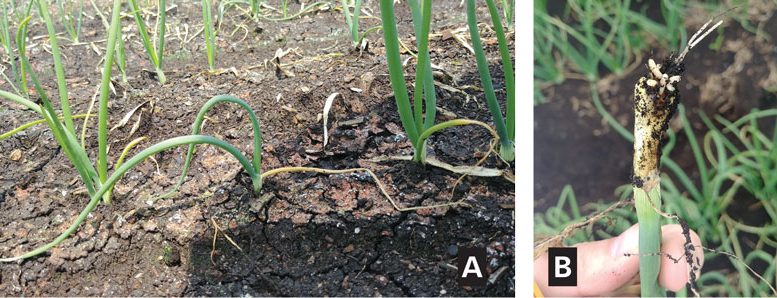Seed Treatment Recommendations for Onion Maggot Control
By Erica Moretti and Brian Nault, Department of Entomology, Cornell AgriTech, Cornell University
When selecting seed treatments for onion, it is important to consider what fungicides and insecticides will be most effective for protecting seedlings against the principal pathogens and insect pests. This article focuses on which insecticide options to consider for managing onion maggot (Delia antiqua), the number one early-season insect pest of onion (Fig. 1).
Onion maggot is a severe pest of onion in northern temperate regions worldwide. In the Great Lakes region of North America, onion maggot has three generations over the growing season, but managing the first generation is the most crucial, as seedlings are at greatest risk for being killed. Larvae feed on the subterranean tissues of onion, entering through the basal plate, and a single larva can consume over 20 seedlings throughout its development. In heavily infested fields, damage to unprotected seedlings can exceed 90 percent, making effective management of this pest essential.
Management Considerations
Management of onion maggot is constrained by a number of factors. Crop rotation can be extremely effective as long as onions are planted a mile away from the previous season’s onion fields or potential overwintering sites such as cull piles. However, this is rarely economically feasible or practical in muck cropping systems. Foliar insecticide sprays have been used to target flies, but this approach is not effective because flies rarely come in contact with lethal doses of insecticide residue. No insecticide rescue treatments exist once plants become infested. Naturally occurring populations of insect predators and other natural enemies of onion maggot do not occur in high enough abundance to reduce maggot populations. Finally, there are no onion maggot resistant cultivars of onion; all cultivars are equally susceptible to feeding.
Given these limitations, insecticide use at planting is the most effective, practical and economically reasonable option for managing onion maggot. Insecticide seed treatments have many favorable attributes over insecticides applied in furrow at planting. For example, seed treatments are safer for users to handle, there is no need for water tanks during planting, less pesticide active ingredient is applied per acre and a precise amount of insecticide is applied to each seed to protect the plant. Consequently, insecticide seed treatments have become the most popular method of protecting onion seedlings from onion maggot.
Seed Treatment Options
There are four seed treatment options currently available for protecting onions against onion maggot (Table 1). These options are also effective against a close relative of the onion maggot, the seedcorn maggot (Delia platura), which also can be a major problem in some fields in some years. Trigard (cyromazine) has been available since the late 1990s, while FarMore FI500 (spinosad, thiamethoxam and three fungicides), Regard (spinosad) and Sepresto (clothianidin and imidacloprid) have been available only within the past 10 years. Among these options, FarMore FI500 has been the most commonly used since it became available. However, concerns over onion maggot populations developing resistance to FarMore FI500 have raised issues about using other options such as returning to Trigard. The big question was how does Trigard compare with FarMore FI500 for maggot control?

1 Listed by the Organic Materials Review Institute (OMRI) for use in organic onion production
2 Also includes three fungicides: azoxystrobin, fludioxonil, mefenoxam
Field Trials
Trigard continues to perform as well as FarMore FI500/Regard. In central and western New York in 2019, onion maggot damage was highly variable with some fields having substantial damage and others very little. In two of the high-pressure fields, we conducted insecticide seed treatment efficacy trials that included currently available and labeled products. Results from those trials indicated that both Regard and Trigard were the best options. In 2019, both Regard and Trigard reduced damage from onion maggot by more than 50 percent compared to fungicide-only controls. And in two different trials, they performed equally as well (Fig. 2a, Fig. 2b). Regard alone performed as well as FarMore FI500, indicating that Cruiser (thiamethoxam) in the FI500 seed treatment is not providing a benefit (Fig. 2a). Substituting Trigard for Regard in the FarMore FI500 package was equally effective (Fig. 2b).
Despite performing as well as Regard and Trigard in last year’s trial (Fig. 2a), Sepresto typically has not managed maggots very well and is not recommended for many areas within the Great Lakes region, although it is used in Canada. Drench applications of Lorsban (chlorpyrifos) continued to be ineffective on its own for controlling onion maggot, as populations on most farms are resistant (Fig. 2a). Neither Sepresto nor Lorsban alone are recommended for managing moderate to high onion maggot infestations based on their performance in our research trials over many years.

Recommendations
Reliance on insecticide seed treatments is the best line of defense against maggots. There are few effective insecticide seed treatments commercially available, and those in the pipeline may or may not become commercialized. Repeated use of the same insecticide on a perennial basis is the perfect recipe for resistance to develop. Therefore, preservation of the most effective options, Regard and Trigard, is essential. Because these products have two different modes of action (Regard is an IRAC Group 5 insecticide, while Trigard is a Group 17), the best way to conserve both is to alternate them on an annual basis to minimize exposure of maggot populations to the same insecticide class, even in low-pressure fields.
Some ask if Trigard will be available in the future. Not long ago, Trigard was divested by Syngenta and acquired by Adama, which caused serious doubts that Trigard would continue to be available as an onion seed treatment option. While Trigard-treated onion seed was difficult to obtain for the 2020 season, it should be widely available and a very good option for the 2021 growing season. If FarMore FI500 or Regard was used in 2020, Trigard should be considered for 2021.

